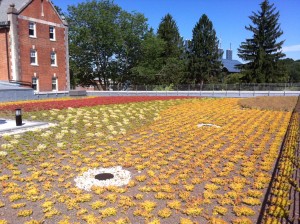If you deal with stormwater issues or land use planning, chances are you have heard the phrase “green infrastructure” mentioned a lot recently. It is rapidly replacing “Low Impact Development” (LID) as the phrase du jour in the stormwater biz. But before we all go willingly adopting this into our lexicon, we must first ask some pertinent questions.
1. What does green infrastructure mean?
If you Google (or Bing, if that’s how you roll) the phrase “green infrastructure” you will discover two related, but slightly different, definitions. Originally the term was used in land conservation circles to describe a planned and managed network of natural resources (forests, open space, waterways, etc.) in a community or watershed. The idea was that we can maximize the environmental benefits these areas provide to our communities by strategically planning where they are and how they can connect. This is very similar to what we have often referred to here at CLEAR as Open Space Planning.

More recently, the term has been adopted by the water quality world to refer to approaches that divert stormwater (i.e., rain/snowmelt) into natural areas, rather than directly into storm sewers (a.k.a. “grey infrastructure”). In doing so, you reduce the quantity impacts of stormwater (flooding, CSOs, etc.), as well as the quality impacts by removing pollutants through natural processes/filtering. Green infrastructure in this context includes utilizing rain gardens/bioretention, rain barrels/cisterns, green roofs, permeable pavements, bioswales, land conservation, urban trees and more.
2. Is Green Infrastructure a new approach or just a new phrase?
For over 20 years the NEMO and National NEMO programs at CLEAR have been working with communities to understand and respond to the impacts of stormwater runoff. When the program started the solutions we offered were called “natural resource based planning” and “site design.” The basic idea was to protect our water bodies and other natural resources first through land use planning, and then through site designs that absorb stormwater close to where it falls. The benefits and impacts on natural resources are taken into account throughout the local land use planning process. In other words, green infrastructure!
So the green infrastructure approach isn’t exactly new, it basically covers the same types of approaches that NEMO has been encouraging since the first Bush was in the White House. But the use of the phrase to describe all those approaches is relatively new. In some ways, it’s better than natural resource based planning, which is a marbled mouthful, and better conveys the essence of what these practices are. However, its acronym, “GI,” is, well, a bit hard to stomach.
3. Does this mean LID is dead (at least as a phrase)?
As I am sure you have noticed, green infrastructure sounds an awful lot like another term we use a lot – LID or Low Impact Development (a.k.a Best Management Practices, Alternative Stormwater Management, etc.) Are they the same thing? Yes and No.
LID can be seen as a subset of practices/approaches within green infrastructure. The difference between the two terms is really one of scale. LID refers to designing and implementing practices that can be employed at the site-level to control stormwater and strive to replicate the pre-development hydrology of the site. Green infrastructure generally refers to a broader, big picture view of a community or watershed and focuses on a coordinated effort to employ these practices along with practices like land conservation. Still, we’re already seeing that distinction diminish as people have begun using the terms interchangeably, regardless of scale.
It should be right about then when a new term bubbles up. But, don’t worry, we’ll still be here (funding willing) talking about the same stuff.